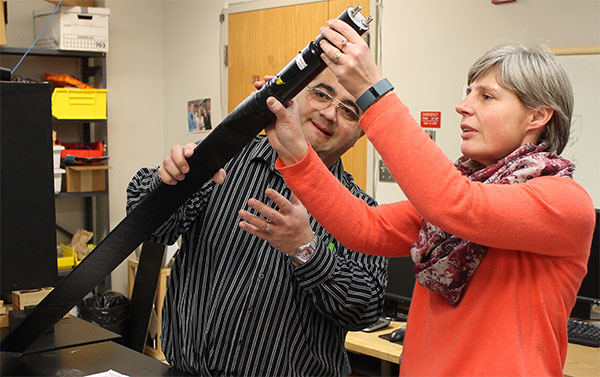How JMU played a role in the $300 million renovation of a national lab
Science and Technology
Is it realistic for an undergraduate school like JMU to play a crucial role in a multi-million dollar upgrade at one of the nation's premiere physics research laboratories?
"Maybe we were a little bold, but we managed to pull it off," a beaming Gabriel Niculescu said as he packaged 40 detectors built by JMU undergraduates and faculty for a road trip to The Thomas Jefferson National Accelerator Facility in Newport News.
Niculescu, an associate professor of physics and astronomy, and his wife, Ioana, a professor of physics and astronomy, supervised a number of students over the past four years to build the devices that look a little like fence slats covered in electrical tape. While their appearance may not be awe-inspiring, their functionality is. The plastic scintillator detectors are designed to measure subatomic particles such as electrons and protons, with a precision of 10-15 meters or smaller. "It's like zero, point, you know, you count the number of zeroes and then something. So at that level, you can't buy it from industry, you need to build it yourself," Niculescu said.
"In the process, the students learn what’s involved in dealing with the companies (that supplied parts) and they acquire skills in physics, math, programming, various branches of engineering and chemistry." _ Gabriel Niculescu
The detectors will be installed in a continuous electron beam accelerator that has been undergoing a $300 million energy upgrade over the past two years, funded by the U.S. Department of Energy. The detectors designed and built by the particle and nuclear physics group at JMU will be installed in experimental Hall C, one of the four experimental areas of the laboratory. The JMU research and development effort was funded through a number of National Science Foundation grants obtained by the Niculescus and Dr. Kevin Giovanetti, professor of physics and astronomy, over the past decade. Physicists use particle accelerators and detectors to explore subatomic particles in search of answers to some of nature's most perplexing questions about the universe, such as: What are the basic building blocks of matter of the visible universe?
Several institutions, domestic and foreign, had roles in designing and building detectors for the upgrade, but JMU was the only primarily undergraduate institution among them. For their efforts, JMU students who worked on the project gained valuable work experience and presented their work at regional and national conferences. "In the process, the students learn what’s involved in dealing with the companies (that supplied parts) and they acquire skills in physics, math, programming, various branches of engineering and chemistry," Niculescu said.
Some of the students even ventured into carpentry to build the crates for shipping the detectors and to build an apparatus to hold the detectors while glue used to fasten photomultiplier tubes dried.
Niculescu said the detectors work something like light bulbs in reverse. "Most light bulbs, you put electricity in and light comes out. This one, we put a teensy bit of light in and we would like an electrical signal that we can measure, put in a computer to tell us something about what it is," he said.
Scientists see the signals as blips on a screen. "It needs to do this blip at the tune of 120 to 150 picoseconds, which means that for every millionth of a second, it should be able to detect four or five (blips)," he said.
In addition to building the detectors, the Niculescus and their students had to test them, a tedious process that was aided by a student invention that incrementally moved the detectors during the process. "That increased our productivity because it could work at night when nobody was watching it," Niculescu said.
Several students who worked on the project went on to graduate school for physics or engineering, a few went into industry and one is teaching high school physics.

